Know your disease
Learn about your disease.

Asthma
Asthma is a chronic disease that affects the airways of your lungs. There are two main problems with asthma in your windpipes. First is swelling and increased mucus in the airways and second is squeezing of the muscles around the airways (bronchospasm). These conditions make it harder to breathe.
Taking medicines and avoiding things that trigger asthma can help control asthma. In the absence of treatment, asthma may be a life-threatening condition.
The treatment of asthma is inhalers. These inhalers have medicines that dilate airways and decrease the swelling and mucus in the airways.
Symptoms
The common asthma symptoms are dry intermittent or seasonal cough and difficulty in Treating asthma by inhalers. These inhalers have medicines that dilate airways and decrease the swelling and mucus in the airways.
- Dry intermittent or seasonal cough
- Difficulty in breathing
- Chest tightness
- Whistling sound from the airways
Diagnosis
Diagnosis of asthma is usually done based on the pattern of symptoms. Spirometry with bronchodilator reversibility is the preferred test for diagnosing asthma, but normal spirometry does not rule out asthma. There are a few other tests also to diagnose asthma.
Treatment
Control asthma by taking prescribed medications and avoiding triggers. Inhalers with bronchodilators and anti-inflammatory agents help dilate airways and reduce swelling and mucus.
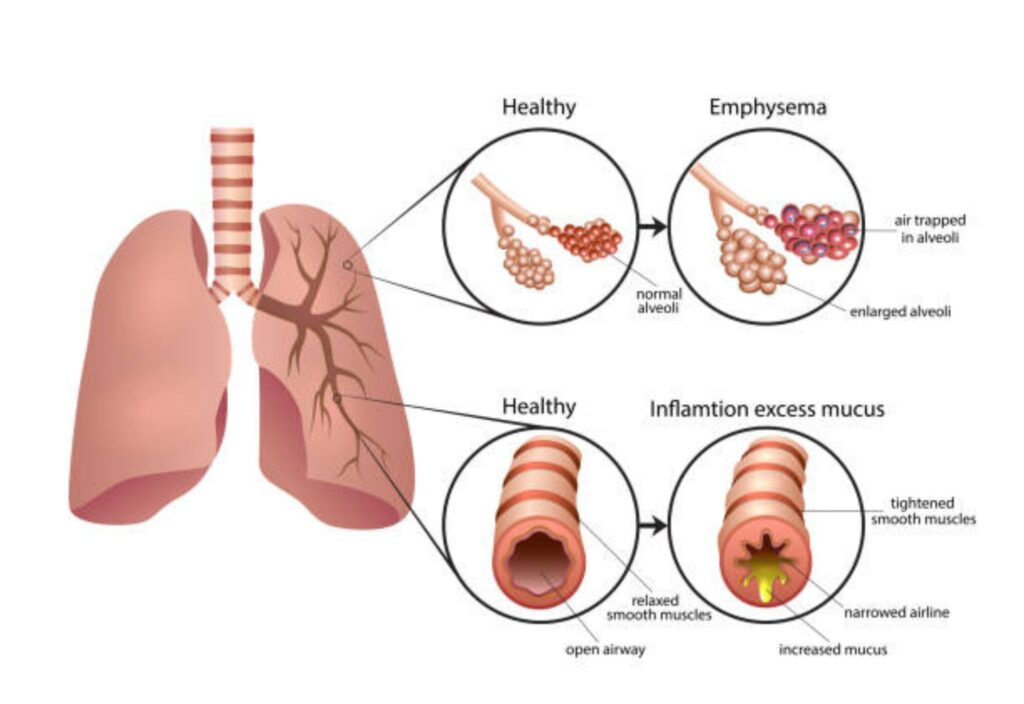
COPD
Chronic Obstructive Pulmonary Disease (COPD) is a preventable and treatable lung disease. People with COPD must work harder to breathe, which can lead to breathing difficulty and/or feeling tired. Early in the disease, people with COPD may feel short of breath when they exercise.
As the disease progresses, it can be hard to breathe out (exhale) or even breathe in (inhale). The causes of COPD are tobacco smoke, biomass smoke, living in highly polluted areas, genetic risk, heavy exposure to certain dust at work, and chronic lung infections like tuberculosis.
Symptoms
Persistent shortness of breath, especially during physical exertion, is a common symptom of COPD, often accompanied by chronic coughing and wheezing.
- Shortness of breath
- Chronic cough
- Fatigue
- Shortness of breath
- Wheezing
- Persistent mucus production
Diagnosis
Diagnosis is typically based on spirometry results. The lung damage in COPD is irreversible, and treatment aims to manage symptoms and slow down disease progression.
Treatment
Quit smoking to slow down disease progression. Medications, pulmonary rehabilitation, and, in severe cases, surgical interventions like lung transplantation may be considered.
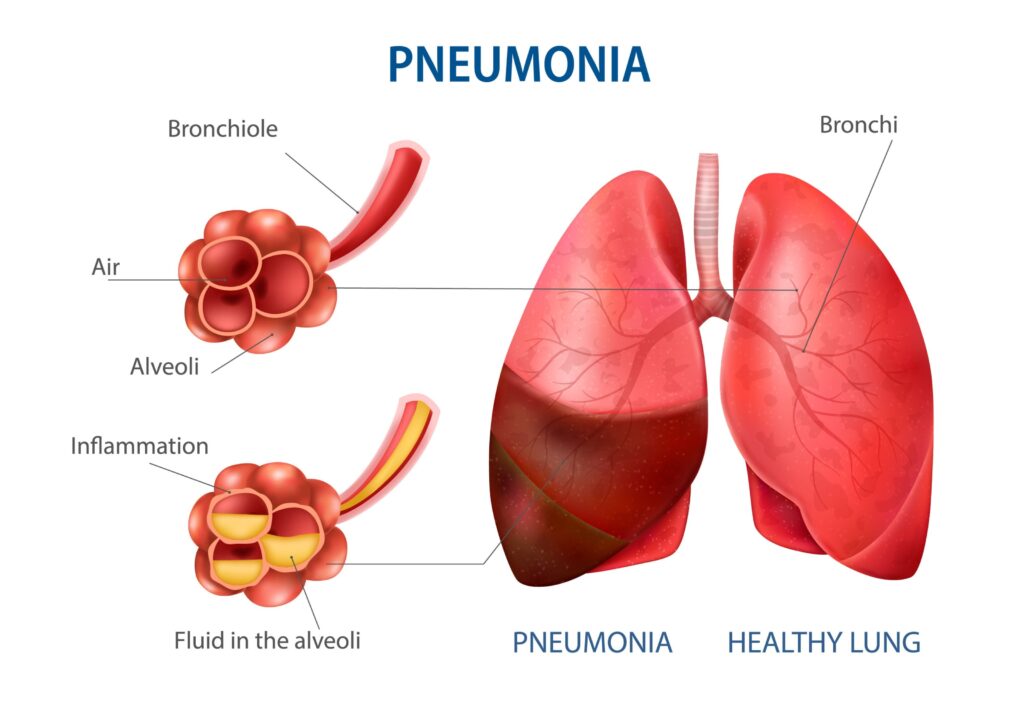
Pneumonia
Pneumonia is an infection in the lungs that inflames air sacs. The air sacs may be filled with fluid, pus, or inflammatory exudates. The situation affects the gas exchange at respiratory membranes.
The infection can be life-threatening to anyone, but particularly to infants, children, and people over 65 years.
Symptoms
The symptoms of pneumonia may be productive cough, breathing difficulty, fever with chills, and in advanced stages organ dysfunction. In advanced cases, hospitalization may be necessary.
- Productive cough
- Breathing difficulty
- Fever with chills
- Organ dysfunction in advanced stages
Diagnosis
Diagnosis involves clinical evaluation, imaging studies, and laboratory tests. Chest X-rays and blood cultures may be used to identify the causative microbe.
Treatment
The treatment of pneumonia includes antibiotics against the causative microbes.
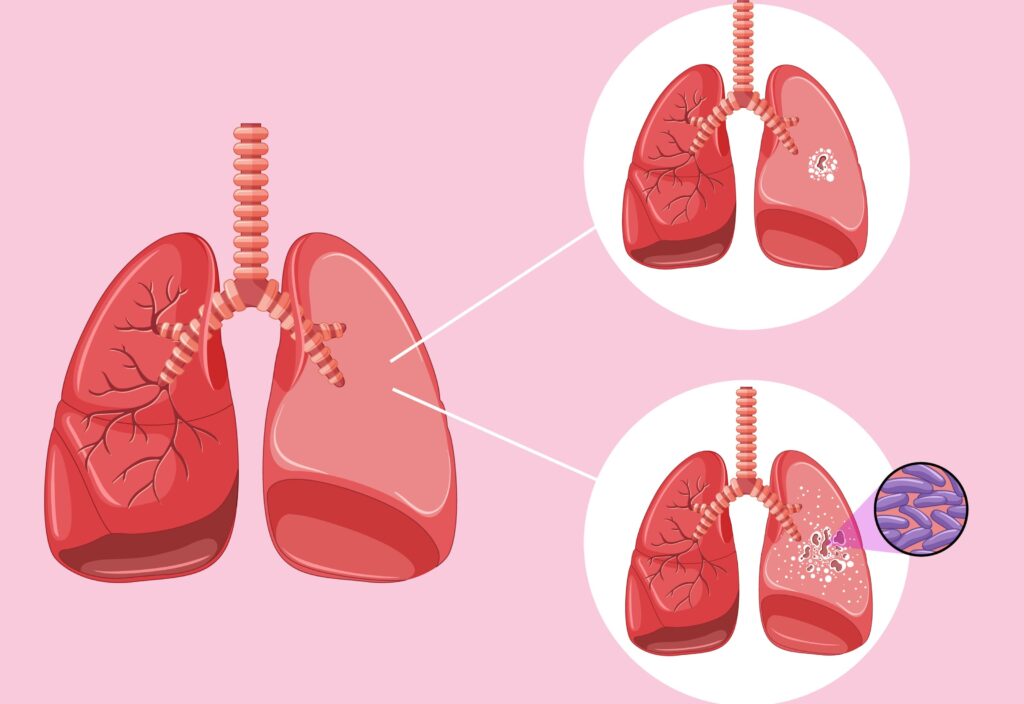
Tuberculosis (TB)
Tuberculosis is a disease caused by mycobacterium tuberculosis that can involve any organ or system of the body.
It most commonly involves the lungs It spreads by aspiration of micro-droplets containing these bacilli means when a tuberculosis patient coughs or sneezes, the bacilli present in the micro-droplets if inhaled by a normal person may get an infection.
Symptoms
Tuberculosis (TB) commonly presents with symptoms such as a persistent cough, sometimes accompanied by blood, along with additional signs like weight loss, fatigue, and night sweats.
- Cough with sputum production
- Low-grade fever, especially in the evening
- Decreased appetite and weight loss
- Blood in cough and night sweats
Diagnosis
Diagnosis includes sputum examination, chest X-ray, CT Scan, and sometimes lung biopsy.
Treatment
The treatment involves a 6-month course of antibiotics. In the absence of proper diagnosis and treatment, tuberculosis may be life-threatening. Non-compliance can lead to drug-resistant tuberculosis, which is harder to treat.
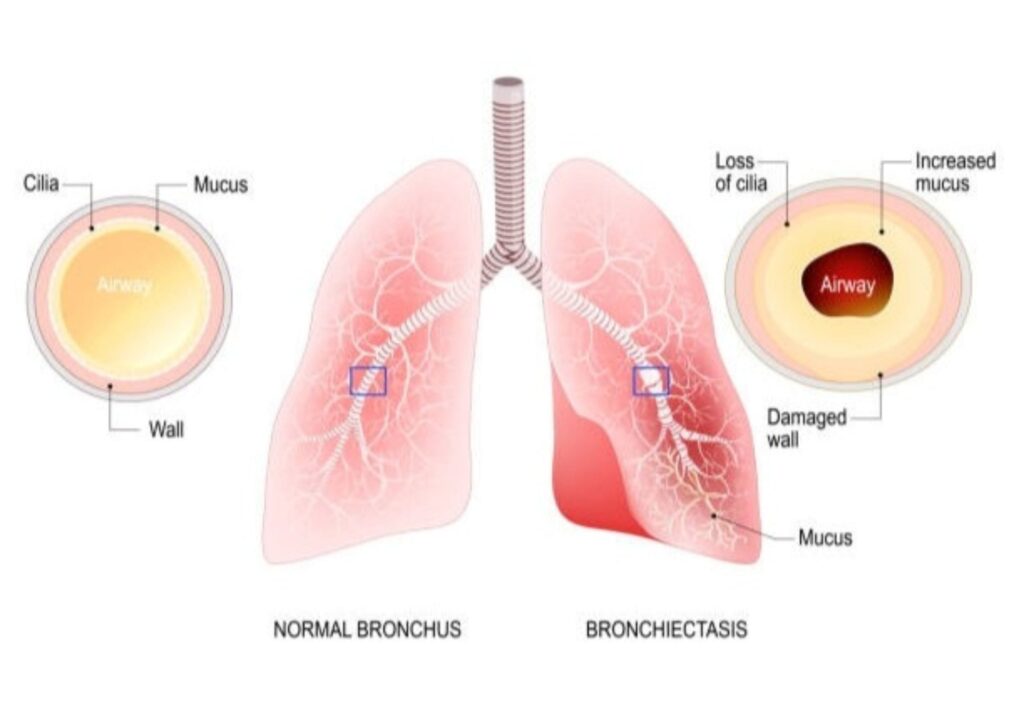
Bronchiectasis
Bronchiectasis is an irreversible lung condition that causes cough, sputum production, and recurrent respiratory infections. The symptoms are caused by abnormal dilatation of the airways of the lung.
This dilation makes it difficult to cough out secretions (sputum, phlegm, mucus) from the lower airways. These sticky secretions provide an ideal place for many kinds of germs to live and grow. This leads to infection and overgrowth of bacteria which leads to inflammation (swelling and irritation).
Infection and inflammation further damage the airways and cause more dilation and worsening bronchiectasis.
The causes of bronchiectasis are genetic diseases (such as cystic fibrosis and primary ciliary dyskinesia), Problems with the immune system (reduced ability to fight infections), Past lung infection, Problems with swallowing causing aspiration of food or fluids into the lungs, and unknown cause.
Symptoms
- Persistent cough with sputum
- Fever, chills, and night sweats
- Difficulty in breathing
- Blood in sputum
- Chest tightness
Diagnosis
Diagnosis involves imaging studies like chest X-rays and CT scans. Pulmonary function tests may also be conducted to assess lung function.
Treatment
Management involves preventing infections and exacerbations. In severe cases, surgical resection of affected lung parts may be necessary.
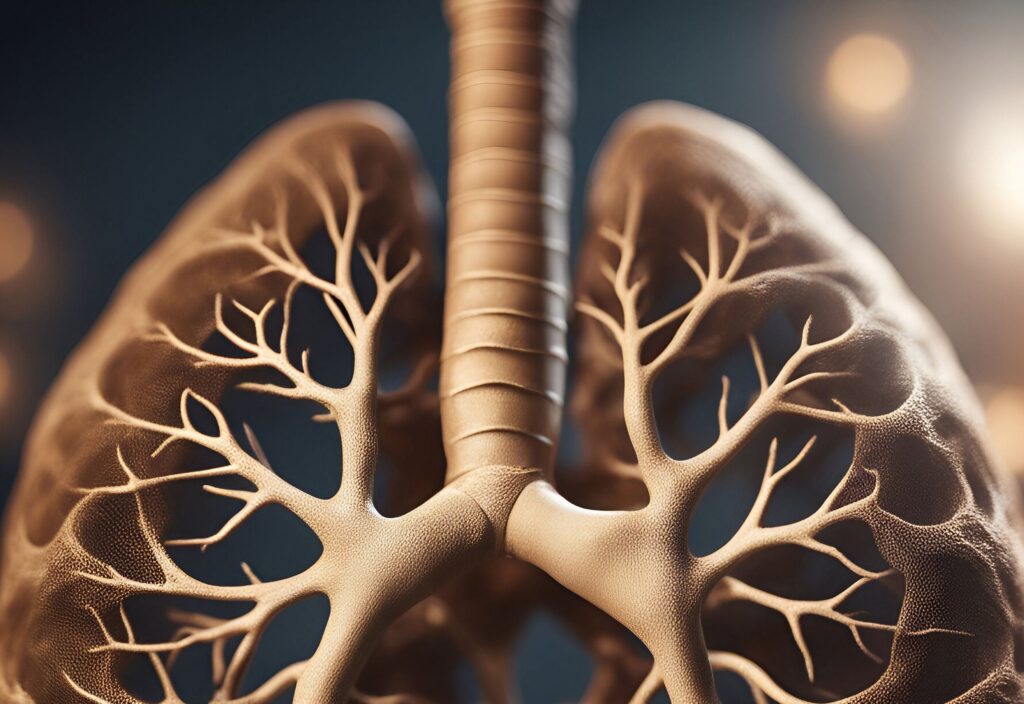
Interstitial Lung Disease (ILD)
Interstitial lung diseases are a group of disorders that cause progressive scarring of lung tissue. This group includes around 300 different diseases.
The reason for ILD may be long-term exposure to hazardous materials (Silica, asbestos, coal dust), exposure to different organic and chemical antigens, auto-immune diseases such as rheumatoid arthritis, and in some cases drugs. Once lung scarring occurs, it’s generally irreversible damage to the lungs.
Symptoms
Symptoms of ILD include a dry cough and gradually progressive breathing problems. The symptoms gradually worsen and at a few points, the patient may require supplemental oxygen to fulfill his/her body’s oxygen demands.
- Dry cough
- Gradually progressive breathing problems
Diagnosis
The diagnosis of ILD is usually done based on certain blood tests, lung function tests, and chest CT. In a few cases, a lung biopsy may be required to establish the diagnosis.
Treatment
Treatment depends on the underlying cause, often involving long-term steroid use. In severe cases, a lung transplant may be considered.
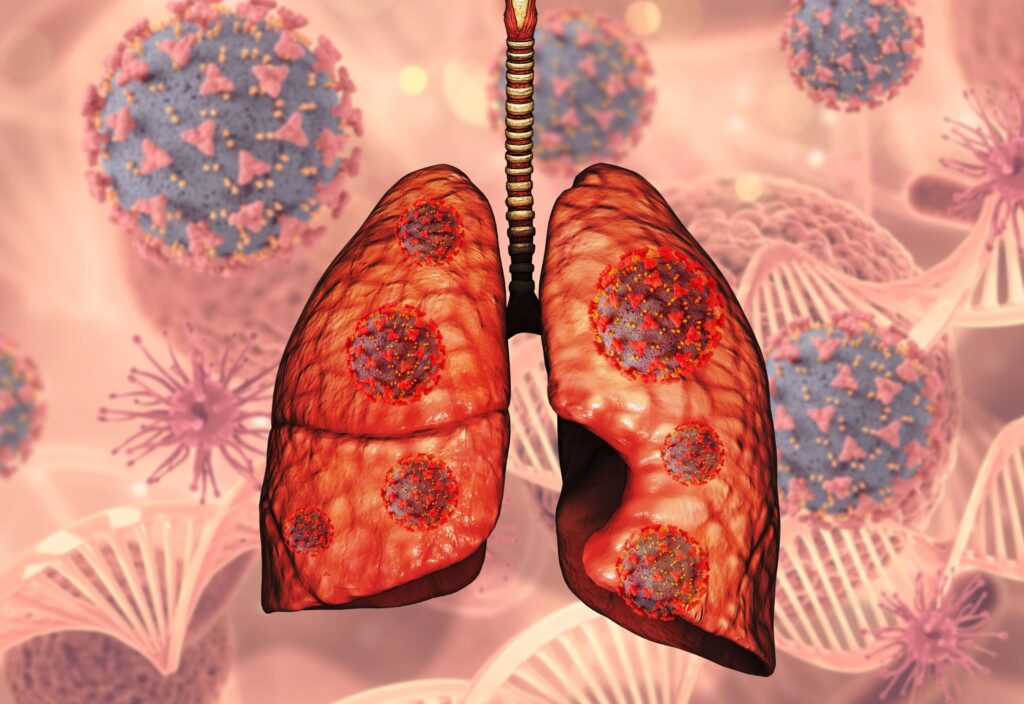
Pulmonary Fibrosis
In pulmonary fibrosis there is thickening of the interstitium, making air sacs stiff so that they are unable to fully expand and hold as much air as they normally should.
This thickening also limits the passage of oxygen through the respiratory membrane. Over time, fibrosis can worsen to the point that patients may need supplemental oxygen to raise low blood oxygen levels, relieve shortness of breath, and improve exercise ability.
Pulmonary fibrosis can happen for many different reasons, including autoimmune disorders, environmental or occupational exposures, as a side effect of certain medications, and a variety of other causes.
Symptoms
The symptoms of IPF are dry cough and gradually progressive shortness of breath. Over time there is also heart involvement in the form of pulmonary hypertension and cor pulmonate.
- Dry cough
- Gradual shortness of breath
- Pulmonary hypertension
Diagnosis
IPF is usually diagnosed on the basis of typical CT scan findings, clinical history, and pulmonary function testing. In some cases, other investigations like blood investigations and lung biopsy may be required for the diagnoses of IPF.
Treatment
Management aims to improve symptoms and includes oxygen therapy, medications, and sometimes lung transplantation.
Is IPF a serious disease?
- Definitely IPF is a serious disease.
- Majority of patients will require oxygen at some point in their life.
- IPF shortens a person’s life. The mean survival in an IPF patient is 3-5 years after the diagnosis.
- Some people may have lung transplantation for advanced disease.
- Over the last decade, advances in the management of IPF have improved the outlook for patients.
- There are certain medicines approved for IPF and many clinical trials attempting to find new therapies

Obstructive Sleep Apnea (OSA)
In a person with obstructive sleep apnoea the airflow in airways is periodically diminished or stopped during sleep which results in poor sleep quality and excessive daytime sleepiness.
In deep sleep, the muscles of the throat relax. Normally this doesn’t cause any problems with breathing. In OSAS, complete relaxation of the throat muscles causes blockage of the upper airway at the back of the tongue.
Normal breathing then slows or stops completely. Such an episode is called an apnoea. In OSAS, the apnoeas can last for several seconds and in severe cases, the cycle of apnoeas and broken sleep is repeated hundreds of times per night.
Risk Factors
The risk factors for OSA include obesity, a small jaw, an enlarged tongue, big tonsils, and a big soft palate. The use of alcohol, sleeping tablets, and tranquilizers before sleep makes obstructive sleep apnoea worse.
Symptoms
- Loud snoring
- Excessive daytime sleepiness
- Morning headache
Diagnosis
Screening of OSA is done based on a questionnaire that includes multiple questions.
Initial assessment is likely to be with overnight oximetry which can be performed at home. This study measures oxygen saturation and heart rate and in most cases provides sufficient information to make a diagnosis.
The diagnosis of obstructive sleep apnoea is established based on a whole night sleep study.
Treatment
Treatment options for OSA include weight reduction, elevation of the head of the bed by 15-30 degrees, avoidance of alcohol, sedatives, and tranquilizers, mandibular advancement devices, CPAP therapy, and surgery.
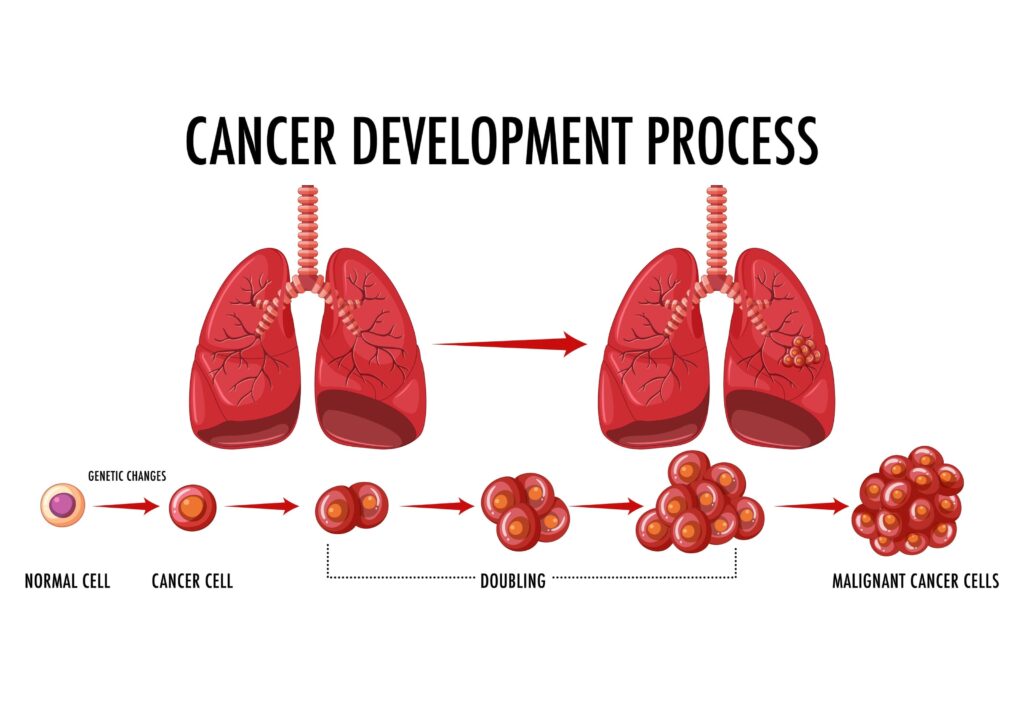
Lung Cancer
Cancer is defined as uncontrolled cell growth in a specific organ that can spread to other organs.
If the cancer begins in lung tissue, it is known as lung cancer. Causes of lung cancer include tobacco smoking, second-hand smoke, exposure to certain toxins, lung scars, and family history.
Symptoms
Symptoms of lung cancer include a cough which often includes blood or blood-mixed phlegm, decreased appetite, weight loss, chest pain, and breathing problems in advanced cases.
These symptoms often don’t appear until the cancer is advanced. Two major types of lung cancer are non-small cell lung cancer and small cell lung cancer
- Cough with blood or bloody phlegm
- Decreased appetite
- Weight loss
- Chest pain
- Breathing problems in advanced cases
Diagnosis
Treatments of lung cancer vary and include surgery, chemotherapy, radiation therapy, targeted drug therapy and immunotherapy.
Treatment
Treatment varies and may include surgery, chemotherapy, radiation therapy, targeted drug therapy, and immunotherapy. Early detection is crucial for better treatment outcomes.
We believe in affordable specialty healthcare for all.
We aims to provide the best diagnosis and treatment across the city.

